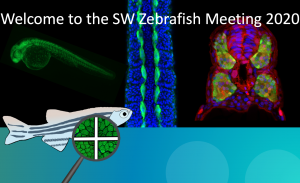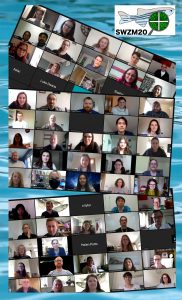The Southwest of the UK – a thriving environment for zebrafish research
Posted by Steffen Scholpp, on 29 September 2020
Meeting report of the SWZM20
The Southwest Zebrafish Meeting 2020 (SWZM20) took place as an online-only meeting organized by the Scholpp lab at the Living Systems Institute, University of Exeter UK, on September 11th 2020. This meeting brought together 90 scientists, mostly from Southwest of the UK, who work with the zebrafish Danio rerio and was supported by a Scientific Meeting grant from the Company of Biologists and from the companies Tecniplast and DanioLab. We provide the readers who might have missed this event with a glimpse of the recent scientific advancements and experimental approaches applied by research groups using fish as a model to understand molecular and cellular mechanisms in development, to explore its role as an in vivo reporter in environmental sciences, and to elucidate common principles in organ regeneration.

To kick-off the SWZM20, Phil Ingham (NTU Singapore) introduced the International Zebrafish Society (IZFS). Then, the first session started with a lecture from Isaac Bianco (University College London), on the usage of zebrafish to understand how neural circuits control complex behaviour in zebrafish. One of their most complex visually guided behaviours is hunting, which begins from only 5 days post-fertilisation. Isaac and his team showed how the larval brain processes visual inputs to identify prey. The zebrafish visualizes specific features of the object, which are extracted and help to identify potential prey leading to the initiation of a hunting routine. During prey tracking, the zebrafish larvae coordinate a directed swim behaviour including turns towards the target. His team could show that that recent experience modulates the core output. His talk was followed by a further talk on fish behaviour from Min-Kyeung Choi (Ryu lab, LSI, Exeter) on the consequences of early life stress on social behaviour. These talks were followed by a session on signalling. Georgina McDonald (Hammond lab, University of Bristol) reported about the function of SMAD9 signalling in developing bones, Chengting Zhang (Scholpp lab, LSI Exeter) and Rachel Moore (Clarke lab, King’s College London) highlighted the importance of cell protrusions in signal transport and signal reception. Finally, Robert Kelsh (Department of Biology and Biochemistry, University of Bath) elucidated on the formation of the stripe pattern in zebrafish by a lattice-based mathematical model helping him to identify the crucial interactions between the different pigment cells in establishing of the distinguished pattern of zebrafish.

The behaviour/cell session was followed by the poster session. PhD students and postdocs from our zebrafish community presented and discussed their work in break-out rooms. After the lunch break, we discussed zebrafish as a model for ecotoxicology. Rebecca Boreham (Tyler lab, University of Exeter) and Sophie Cook (Lloyd-Evans lab, University of Cardiff) presented their data on the usage of transgenic zebrafish larvae as in vivo sensors of chemical-induced stress and the toxicity of iron oxide nanoparticles. This session was closed by a lecture from Charles Tyler (School of Biosciences, University of Exeter). In his work, transgenic zebrafish lines are developed that are sensitive to endocrine disruptors such as oestrogen-like chemicals. The transgenic zebrafish lines allow his team to identify where different chemicals interact in the body and in real-time. This is a very powerful tool to investigate the potential for wider health impacts of exposure to environmental oestrogens. Members of his team also work on other chemical contaminants of environmental and human health concern including pesticides and pharmaceuticals and how the zebrafish can help us to detect them and learn more about accumulation in specific organs. This was followed by a talk from Gregory Paull (Aquatic Resource Facility Manager, University of Exeter) on the important balance of husbandry with scientific research.

In the final session of the day, the importance of zebrafish research in elucidating general principles in organ regeneration was discussed. This session started with four short talks from Daniel Wehner (MPI Erlangen, Germany) on axon regeneration; Paco Lopez-Cuevas (Martin lab, University of Bristol) on reprogramming macrophages and neutrophils; Noemie Hamilton (University of Sheffield) on microglial function and its contribution to the pathology of a childhood white matter disorder; and Rebecca Ryan (Richardson lab, University of Bristol) studying the role of Osteopontin in zebrafish cardiac regeneration. The session was closed by a lecture from Catherina Becker (Centre of Discovery Brain Sciences, University of Edinburgh) on investigating the cellular mechanism underlying regeneration of the zebrafish spinal cord. In her talk, she was focussing on the active spinal cord progenitor cells around the lesion and elucidated lesion-induced neurogenesis.
To end this wonderful day, the best posters and talks received prizes according to a qualified majority voting. Two delegates won prizes for their fantastic talks. Georgina McDonald, from the University of Bristol, gave an impressive talk that showed us how SMAD9 is regulated and expressed in zebrafish skeletal elements. Rachel Moore, from KCL, explained how actin-based protrusions lead microtubules during axon initiation in spinal neurons in vivo. A further two delegates won prizes for their informative posters. Aaron Scott, from the University of Bristol, displayed a colourful story on in vivo characterisation of endogenous and cardiovascular extracellular vesicles in zebrafish. Lastly, Yosuke Ono, from the University of Exeter, created an enlightening poster on post-embryonic development and growth of slow-twitch muscle fibres in zebrafish. All talks and posters presented were deserving of awards, but these were particularly exceptional from a scientific and exhibitive perspective.
The powerful imaging techniques, the emerging tools to study complex vertebrate behaviour, the possibility to study in vivo cell biology within a living organism, and the usage of zebrafish in analysing the effect of chemicals on an organism are only a few of the many reasons why zebrafish is and will remain an excellent research model in the future. And another reason to work with zebrafish became obvious during this day: Working with zebrafish makes you part of a fantastic, noble and lively community. The SWZM20 was an outstanding celebration of this wonderful fellowship. The SWZM20 with delegates from diverse backgrounds further underscored the need for close interaction in the zebrafish research field. Despite some local collaborations in the Southwest of the UK, a stronger network still has to be developed between the four main scientific centres of Exeter, Bristol, Bath and Cardiff. We thereby hope that the SWZM20 could serve as a springboard for even more future interactions from basic biology to translational research.
And this is also a reason why we are looking forward to meeting again next year for the SWZM21 in Bath!
 Steffen, Lucy,
Steffen, Lucy,
Holly, Chengting,
Yosuke, Josh,
and Michael


 (5 votes)
(5 votes)